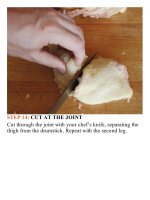The food lab better home cooking through science ( PDFDrive ) 94
Bạn đang xem bản rút gọn của tài liệu. Xem và tải ngay bản đầy đủ của tài liệu tại đây (213.8 KB, 2 trang )
Q:What’sinsidetheeggthatmakesitsoculinarily
useful?
Therearetwobasicpartstoanegg:yolkandwhite.
The yolk is the nutritive source for the developing
embryo,anditaccountsforabout75percentofthecalories
inanegg.Yolksmayappearrichandfatty,but,infact,they
areessentiallysacksofwaterthatcontaindissolvedproteins,
along with larger masses of protein and fat linked together
withlecithin, an emulsifying molecule that allows fat and
watermoleculesgetalongtogetherharmoniously.We’llget
backtothatinamoment.
Thewhiteisalsomostlywater,alongwithafewproteins
—the most important beingovalbumin, ovomucin, and
ovotransferrin,whichgiveititsuniquecapacitytobothset
whencookedandbewhippedintostiff,shavingcream–like
peaks.
Because the proteins in eggs are already dissolved and
spread out in a liquid, it is very easy to incorporate them
into other foods—much more than, say, meat proteins,
which are relatively firmly set in place in relation to one
another. (Have you ever tried whipping a steak? I have. It
doesn’twork.)Additionally,thefactthateggscontainsuch
a wide variety of proteins, each of which behaves in a
slightly different way when heat or mechanical action is
applied, means that as a cook, you have great control over
the final texture of your finished dish. Eggs cooked to
140°F, for example, will be soft and custard-like, while
thosecookedto180°Fwillbebouncyandfirm.
Labeling:SizeandQuality
Q:Eggscomeinafewdifferentsizesatthesupermarket.
WhichonesshouldIbereachingfor?









